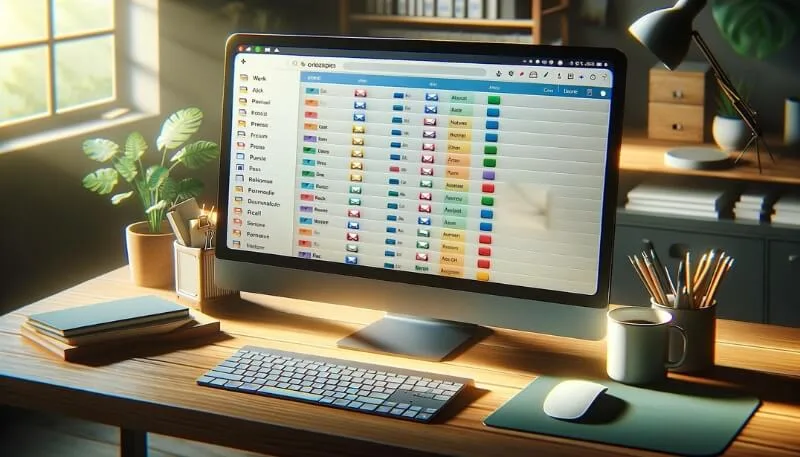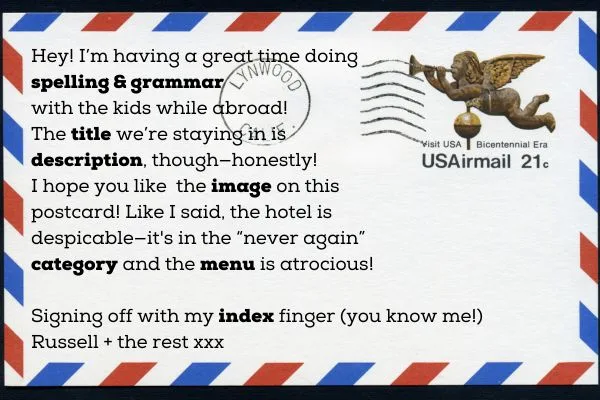Last updated on January 19th, 2025 at 01:22 pm
I’m breaking down the ten steps to affiliate marketing success into ten easy-to-manage blog posts. This leads me to Step 2 of the Positivity Mantra… I am organized! I’ll mainly discuss how to be more organized as an affiliate marketer, but there’s general advice here, too.

As with my earlier article on patience, you might wonder what being organized has to do with affiliate marketing. I can confidently say that you’ll soon find out. My lessons are from learning the hard way, after all.
With that in mind, let me explain why the habit of being organized will be pivotal to the stability of your new business venture. I’ll throw in a few tips, too, so you can add structure to your growing list of skills. You did make a list, right?

How to Be More Organized as an Affiliate Marketer
A focused mind will clear your path to online success, and you’ll quickly learn how precious your “working time” is. This is especially true if you’re also working full-time, running a household, and/or have other responsibilities you can’t avoid. I wish I had known how to be more organized when I started, so I’ve put together some techniques and actions you can take to avoid losing your way. It will help you manage your affiliate marketing affairs from the start.
Your business and your state of mind will be conditioned for success if you put these things in place now:
Define Your “Working Time”
The first thing you need to do is define what your “working time” is going to be. This will, of course, be determined by your current circumstances at home and at work. Is this going to be a weekend jaunt for you? How about finding a couple of hours each day to work on your website once the kids are in bed? Is it going to be your primary vocation? If so, you’ll want to put a decent shift in each day, perhaps with a day or two off each week (good luck with that).

In my “Is Affiliate Marketing Difficult?” post, I mentioned the time burdens of running an online business. That said, taking a disciplined approach from the start is fundamental. Decide how much time you can realistically and consistently spend each week working on what will essentially be an unpaid pastime in the early stages. Be it 10, 20, or 40+ hours per week, this is the designated time to build your online business. It’s your map for success, and you need to commit to it.
The next step is deciding how you will use your working time. It will be taken up by the following tasks:
Researching & Writing Content
Researching and writing content is the bread and butter of your business, so you need to spend at least 80% of your time on creation. Schedule trips to the library if you need them, but make sure there’s plenty of time dedicated entirely to the business of writing.

Learning New Skills / Training
Another great use of your time will be learning your craft. This could include acquiring technical abilities, marketing know-how, problem-solving skills, or any other focus that will improve your ability to grow your website and its audience.

Completing training that fits your needs can take 10% of your time and help you gain more efficiency. I trust Wealthy Affiliate and its members to fulfill my requirements.
Administrative Tasks
Let’s say, for example, that 5% of your time will be spent running your website. The regular humdrum includes:
- Checking and responding to emails or comments.
- Updating plugins (tools you can add to your WordPress website to improve functionality or appearance).
- Checking or applying for affiliate programs to build your portfolio.
- Planning. Don’t forget the planning!

Social Engagement / Website Growth / Website Improvement
You’ll want to draw attention to new posts on your social media accounts or be seen as active there, so make time to promote your website in this way. Not too much time, though, as it’s too easy to get sidetracked on these platforms. Keep your business head on when using social media during your “working time.”

It’s also essential to revisit historic posts occasionally. Do this to ensure they’re still relevant and correct or improve anything that needs a shine. Are they performing well in search engines, for example, or do you need to optimize them by making the subject matter of your posts more explicit or engaging?
Miscellany
Miscellaneous tasks will also arise, so include some wriggle room in your planning. If it’s not used for odd jobs, then please create more content! We’re running out of percentage points, so the remaining 5% of your “working time” can be used to champion your website (see above) and miscellaneous tasks.
A “Working Time” Example
If I set aside 2 hours each day to work on my website (14 hours per week), I might choose to write, research, or publish for 11 hours and 12 minutes of my “working time.” I’ll spend an hour and 24 minutes training myself, 42 minutes on social media, and the same on other stuff.

Don’t worry, I’m kidding. Chances are the “other stuff” will be watching the clock! This isn’t going to work.
As a beginner, I must spend at least 6 of my 7 days writing. I can train and plan on the seventh day (religiously) until this schedule outgrows its effectiveness. I’ll need more time to drive traffic as my website grows, so I’ll re-evaluate my “working time” when I reach 50 posts. That’s an arbitrary number for the purpose of my plan. You can choose your own.
My new website’s “working time” plan will be content and training. I will follow my schedule so that at least 14 hours of my week will be spent building my online business. The goal of monetizing my plaza and how I go about that will come soon, but not yet.
I can’t stress enough the importance of managing your time so you can understand your output. Spending 10 hours on your website is all well and good, but if you haven’t produced anything of value for your visitors, it is time lost. Minimize that.
I have a plan for my foreseeable future that makes me feel good, focused, and unfettered. I am organized! I recommend you do yourself a favor and define your “working week” now. I can wait…
Are things looking clearer already?
The Difference Between Goals and Targets – Set Your Goal!
A goal is what we want to achieve. It’s the long-term objective that keeps our pulses pulsating. It’s the person we aspire to be and the lifestyle we want to adopt. It’s a beach somewhere or a house that we own. It’s having a family of fourteen or the keys to the White House / No. 10. It’s getting remembered as a pillar of humanity or rich enough to buy out Amazon.

Our goal is our spur, our motivation. It’s the light shining from the end of a formidable tunnel. Or perhaps it’s just that we want to make money from our websites, right? Write down your goal on the front page of a diary. We’re getting your show on the road, so let’s be clear about your aim now so we can forge ahead.
Our targets are the means to this end. They are the hurdles we click our heels to jump over, the exams we study rigorously to pass, the milestones of travel to a desired location, or the elections we need to win to become president or prime minister.
It’s also putting posts on a website in a certain amount of time, pushing the limits of our abilities to please a healthy audience. It’s growing that audience by creative or skilled means or the 10 steps to affiliate marketing success that make us optimistic that our goal will become our reality.
Set Your Targets and Work on Them
I challenge you to make a list of targets for the coming week. It doesn’t matter if you haven’t set up a website yet. Reading this article and making plans is doing the seventh day early, okay? I won’t tell.
List 10 things you will achieve this week within your “working time” that will move your business forward. It’s a habit you need to get into.
I break my own targets down to the practical and what I call the “growth gradual.”
The Practical
Content objectives are a priority. I know the number of posts I want to deliver in a week, their names or subjects, and what my blog count should be each month. I also set a stretch objective, which basically exceeds these numbers. If I overachieve, I reward myself by eating out. It’s rare because my targets are based on realistic assessments, and I recommend you do the same.

Practical targets also include completing training in areas of weakness, implementing new functionality or marketing techniques on my websites, social media activity, and admin tasks.
I didn’t at first, but I now monitor the time it takes me to research, write, and publish a post. I know I’m quicker at it than I used to be, so the challenges I set myself increase accordingly. I want to know I’m squeezing the most out of my time because no one else is monitoring me. Someone would if I were an employee doing this, and I want to satisfy my boss (it’s me!).
The Growth Gradual
I limit the analysis of my websites’ performance to once each month. It will burn your time and your morale to do it more often. I know that overall traffic (visits to my websites) will grow exponentially (more content = more visitors), and I measure that progress. I also know that my websites are still young, so I haven’t defined a target number of visitors or an income target yet. I merely want to see upward momentum as I plow on.
I will eventually need to be more granular in my analysis, but right now, I only need to know that my efforts aren’t tanking.
Manage Your Emails
Before you get going, set up a new email address for your business. It’s best if you have different contact details for your business than you do for your website, and both should be separate from your personal email. This will allow you to separate visitor and supplier contacts. You also won’t have the confusion of personal emails getting caught up with your business information, which may distract you during “working time.”
Supplier contact will be from companies you affiliate with and service providers (web hosts, training facilitators, etc.). I set up separate folders for each of my primary email contacts, so any information is easily found when I need it.

Email can be a primary source of clutter, so manage your emails with an effective filing system and delete the ones you don’t need (do this immediately). Also, have an email folder for receipts. You don’t know when you might need them for tax and accounting purposes, so don’t delete them, thinking it’s just a paper (well, email) exercise. Get in the habit of keeping financial records!
Keep Accounts
From the start, keep a spreadsheet setting out what you spend on your website and any income you receive. When your website is in full flow, you’ll want to analyze this more, with many satisfying graphs when the income exceeds your costs!
There’s no harm in indulging yourself when you reach this milestone. Celebrate every success in affiliate marketing, especially when you make your first sale. You will have worked tremendously hard to achieve this, so you deserve it!

Store Affiliate Program Information
The list of companies you represent will surely grow, so manage a spreadsheet for them as soon as you sign up for your first affiliate program. It’s easy to forget what you’ve signed up for after a while, so get this set up at the first opportunity.
The essential information you need is the company name, login URL (web address), username, password, and affiliate ID (this is the identifying code, number, or name that links a referral to you). Sometimes, you should also note what products or services the company sells. Most affiliate portals have their own statistical information, so don’t overcomplicate your spreadsheet with extra details.

Some affiliate platforms manage programs for many different organizations. I add an extra column to my spreadsheet for these, identifying both the company and the affiliate platform. This is because you may represent multiple companies under one umbrella.
In addition to storing these details for memorability, you will need the information when you disclose any partnerships you have (called an affiliate disclosure).
Manage Your Blogs
I don’t want to get too technical in my “positivity mantra” posts, but organization is a methodology rather than an ideology, so I need to mention some things.
Each blog you write will focus on a “keyword.” A “keyword” is the term people type into search engines when looking for information online. It can be confusing, but something like “How do you make custard?” is a keyword.

For your website, you will intentionally propose a focus keyword, which will usually appear in the title of your post. It’s another spreadsheet, everyone!
I prefer to insert a new worksheet after my affiliate one so all my information lists are on one file. Your first column will be the name of each post, and the second will be the target keyword for that post. Don’t use the same keyword twice, and that’s the purpose of keeping this information handy. You will lose track of all the keywords you’ve used as your website grows, so it’s a helpful tip to have your post information in one place.
You may want to record other details for each post on your spreadsheet, too, but it’s best to figure out what you need as you become more familiar with your website. Internal and external links are two I can think of, but my advice is to avoid duplicating information that you can find somewhere else.
Remember, avoid duplicating information that you can find somewhere else. Ha.
Keep Notes of Ideas & Maintain a To-Do List
Every time I sit down to write or research, my head spins like the blades of a helicopter, and the whirl of its motion risks slicing my fingers. This is great because I’m generating ideas, and every writer lives in fear of their imaginations crash-landing on them. I mustn’t hover over these new ideas for long, though. I must focus on the task and get the post I’m doing written first.
Of course, I record new ideas as I go along. I have a notepad whenever I write, where I scribble the notions that seek to destroy my concentration. These ideas get amalgamated and rationalized at the end of each day. I amend my writing schedule to accommodate them.

My technique is to keep an electronic calendar and a separate document where I map out the different stages of my projects. These get slotted into my calendar, so I achieve my targets in a structured way. I also know when they will be complete: healthy knowledge and fun!
For this website, I will complete my series of posts for the mantra before I work on anything else. I then want to review Wealthy Affiliate and Solo Build It! (both now complete), as I think you’ll find both beneficial for your development. From writing this article, I have ideas about writing posts related to:
- Setting writing targets.
- Project planning for websites.
- Finding affiliate programs that relate to a website’s content.
- How to research and use keywords in a post.
- How to find a website niche.
I’ll schedule these to be completed after my other work. I will also note that I should update this post for each calendar entry. After publishing these articles, I’ll hop back here and add links. I’ll also change this section to reflect on that process.
Do you see how this helps me understand the future dynamics of my website? It’s a motivating practice that serves my planning objectives and organized approach to this work. It is how to be more organized as an affiliate marketer!
Find a scheduling system that works for you. The advice is to ensure that you do have a plan! You’ll feel good about it, and it’s not an onerous task.
Have a Publishing Checklist
After slamming my index finger on the full stop button (a flourishing mark of aggression to signify my post is finished), I rush to publish it for all the world to see. It’s here at the end, in excitement and relief, that I’m known to have made the most basic of mistakes. I didn’t do my checks!
Nowadays, I let my post sit for a night’s sleep before publishing. I then get my 4” by 6” postcard, on which I’ve written my publishing checklist. It reads…

I jest! My bland card really reads:
- Spelling & Grammar Check: Don’t publish a post without doing some form of proofreading. I use MS Word, but Grammarly is a free resource that many rely on for this.
- Meta Title & Meta Description: Search engines use these to display posts on their result pages. Your post title should be at most 60 characters. You should also include a descriptive passage, aiming for 145-155 characters and no more than 160.
- Feature Image: Ideally, you want to set an image that reflects your post so this picture can be featured on category pages and other places (like on the post itself!).
- Category: Categories are sub-sections of your website that group related articles together. Don’t forget to assign your new post to one of them or a new one.
- Menu: Ensure your post can be accessed from the navigation menu. Are there any links you want to add from other posts, too?
- Indexing: The final task is to inform search engines about the new post. They will find these automatically, but you can speed up the process by submitting them for indexing. Now is also an excellent time to share your latest offering on your social media accounts.
I realize I’ve shared a lot of information here, but strategy cards, or process cards, are a valuable aide for content creators (also called “publishers” to throw in more jargon for you).
How to Be More Organized in General
These are a few ideas if you need guidance on being more organized in your day-to-day affairs. I know that life can sometimes seem like a scattered mess (when it isn’t cramped and hidden in a drawer somewhere).
- Recite the positivity mantra: Reading motivational quotes as part of your morning routine will stimulate your focus for the rest of the day.
- Avoid clutter and distraction: A messy mind leads to muddled output. Clear your space and concentrate on one task at a time to increase your productivity.
- Keep and maintain a to-do list: I’ve mentioned this already, but ruling a line through a task or marking a tick is very satisfying. It’s like shopping!
- Don’t procrastinate: If you read “avoid clutter” just now and thought you better tidy up before starting, have another word with yourself. It definitely needs doing, but…
- Prioritize: In life and work, some things can’t be done before others, and some things are more important than others. Dust from the top, but be sure to dust, as the saying would go if I hadn’t just made it up! Have a do-or-defer attitude and make your plans in order of sequence.
- Get quick tasks done quickly: Do the fast and easy jobs first for a morale boost. Put on your jetpack and stock up on pens because that jobs list is taking an ink-scratched whipping! It’s not cheating if you rifle through a dozen jobs in no time before doing battle with the final boss. It makes sense even, as the more significant challenge will affect your time and energy.
- Know where things go: It doesn’t make sense to put things away haphazardly unless your mother is on her way to visit. A dedicated drawer is not the exclusive right of socks! Have a place for everything, and your home will be a happier place to hunt. After all, you know it will save you time in the long run if you always put your car keys in the same place, right?
- Use the trash can/dustbin: Ha! I’m sure you can relate to this one. Be in the habit of throwing things away once they’re used. If you don’t know why and when you’ll need it, bin it!

Final Words on “I Am Organized”
I appreciate that organization can be a dry topic and not readily associated with positivity. However, adding structure to your busy world will give you an optimistic glow. There is a serenity to be found in knowing your direction of travel and having a clear purpose. You’ll feel it bubble inside you like a happy kid with sweets as you work on your website.

You have a plan in your head and in your diary, which will give you the confidence to believe that your young, lean website will become a fleshed-out heavyweight. It will do, but only if you stick to your guns and hit all your targets.
I have my own battles with keeping my workstation tidy. It’s a terrible landing spot for chocolate wrappers right now. It will get tidied, and I’ll update my schedule before I wrap up for the night. First, though, I need to get out my 4″ by 6″ and publish this post.
I hope I’ve given you a good direction on how to be more organized as an affiliate marketer. Now it’s your turn!
Next Steps: Start Making Money
Keep the momentum going with my positive post on how affiliate marketers make money by sharing.
Resources: Starting an Online Business for Dummies
The Starting an Online Business for Dummies book can be your all-in-one solution to getting started and keeping your shop in order. It has advice on funding, SEO, marketing, and planning. While not explicitly targeted at affiliate marketing, you will find many relevant tips that may inspire you to scale your business. You can pick it up at Amazon or Barnes & Noble now (as an Amazon Associate, I earn from qualifying purchases).
Please let me know in the comments if you have any thoughts on how to be more organized as an affiliate marketer. Likewise, if you need to vent about the chaos you’ve created for yourself and have found my advice lacking, I’ll respond and assist if I can.




